
|
You entered: solar eclipse
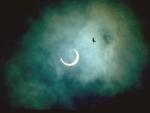 A Fleeting Eclipse
A Fleeting Eclipse
27.08.1997
A lunar eclipse can be viewed in a leisurely fashion. Visible to anyone on the night side of planet Earth (weather permitting), totality often lasts an hour or so as the moon glides through the Earth's shadow. But a solar eclipse is more fleeting.
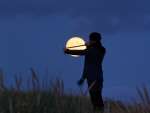 Moon Games
Moon Games
1.08.2008
The Moon's measured diameter is around 3,476 kilometers (2,160 miles). But apparent angular size, or the angle covered by an object, can also be important to Moon enthusiasts. Angular size depends on distance, the farther away an object is, the smaller an angle it covers.
 The Crown of the Sun
The Crown of the Sun
8.08.2008
During a total solar eclipse, the Sun's extensive outer atmosphere, or corona, is an inspirational sight. The subtle shades and shimmering features of the corona that engage the eye span a brightness range of over 10,000 to 1, making them notoriously difficult to capture in a single picture.
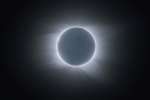 The Crown of the Sun
The Crown of the Sun
21.07.2010
During a total solar eclipse, the Sun's extensive outer atmosphere, or corona, is an inspirational sight. Subtle shades and shimmering features that engage the eye span a brightness range of over 10,000 to 1, making them notoriously difficult to capture in a single photograph.
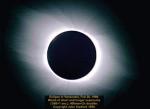 A Total Eclipse of the Sun
A Total Eclipse of the Sun
10.03.1998
On February 26th, it was dark during the day. This total solar eclipse was the last visible from the Americas for this millennium. A total solar eclipse is exciting partly because it is so short.
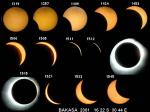 Bakasa Eclipse Sequence
Bakasa Eclipse Sequence
6.07.2001
Starting at the upper left, this sequence of images follows the progress of the magnificent 21 June, 2001 solar eclipse in the clear skies over Bakasa, Zimbabwe. These pictures were recorded using a small reflecting telescope and digital camera with the approximate local time given above each frame.
 A Partial Eclipse Over Manila Bay
A Partial Eclipse Over Manila Bay
20.05.2012
What's happened to the setting Sun? An eclipse! In early 2009, the Moon eclipsed part of the Sun as visible from parts of Africa, Australia, and Asia. In particular the above image, taken from the Mall of Asia seawall, caught a partially eclipsed Sun setting over Manila Bay in the Philippines.
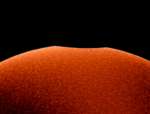 A Nibble on the Sun
A Nibble on the Sun
13.07.2018
The smallest of the three partial solar eclipses during 2018 was just yesterday, Friday, July 13. It was mostly visible over the open ocean between Australia and Antarctica. Still, this video frame...
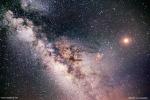 The Milky Way Behind an Eclipsed Moon
The Milky Way Behind an Eclipsed Moon
3.06.2003
What's behind the Moon? Each month, our Moon passes in front of -- and outshines -- many an interesting star field. Exceptions occur during a new Moon and during a total eclipse. In the background...
 A Partial Eclipse in Southern Skies
A Partial Eclipse in Southern Skies
3.09.1997
Location is everything, especially if you want to see a Solar Eclipse. These fleeting events are only visible to those in the path of the Moon's shadow as it races across the Earth.
|
January February March April May June July |
|||||||||||||||||||||||||||||||||||||||||||||||||